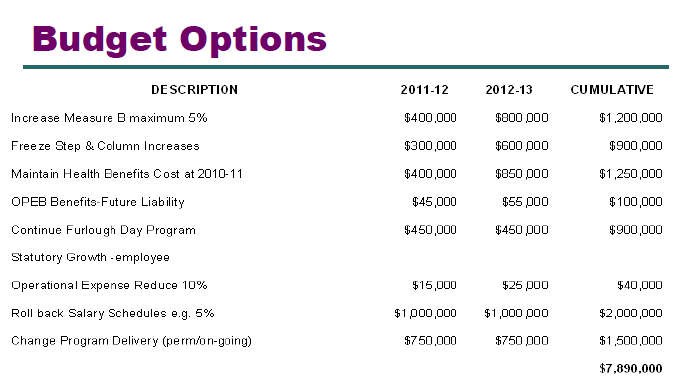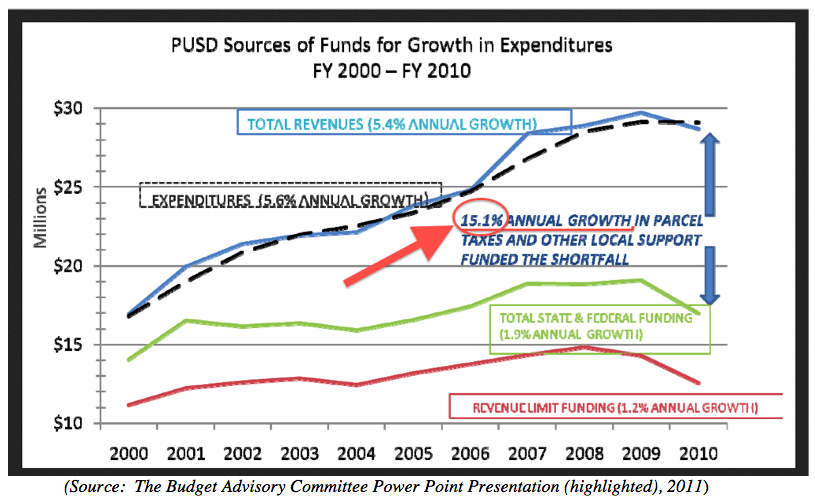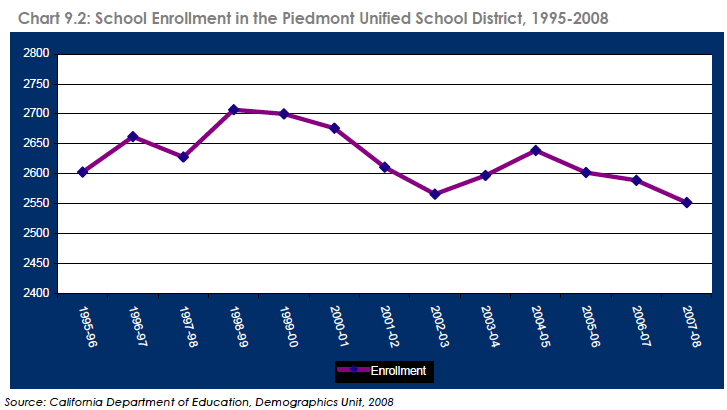Part 3: Piedmont School District Facing a Quandary
Part 3: A Close-Up Look at Piedmont School Financial Decisions 2000 to 2011 –
- Part 1: A $1 Million Problem – Temporary or Ongoing?
- Part 2: Piedmont Parcel Tax Facts
- Part 3: Piedmont Schools Face a Quandary
- Part 4: PUSD Deficit – $1 million or potentially $2.5 million
Following Proposition 13, Piedmonters rallied behind the City’s public school district to enact a school parcel tax. Voters rallied once again to triple the Piedmont school parcel tax over 6 years (2006 to 2011) to maintain Piedmont per-student spending. The Piedmont tax is now $1,000 to $2,500 more than any other school district in Alameda or Contra Costa counties, including Lafayette, Moraga, and Orinda.
Continued growth in the Piedmont school parcel tax has been deemed unsustainable by school leaders. Local taxpayer funding has grown at an annualized rate of 15% from 2000 to 2011. On September 16, 2010, Piedmont School Board members “thanked the community for its financial support for education, including the emergency parcel tax, but all agreed that relying on private funding and temporary fixes is not sustainable — a more permanent solution is needed.” (See September 2010 Piedmont Neighborhood News article.) The Citizens Advisory Committee for the School Parcel Tax (CAC) recognized the need for support will be intense (at p. 6), but states, the “historical rates of increases in parcel taxes cannot be sustained in the future, and that existing levels may already impose unsustainable hardships on fixed-income and low-income taxpayers.”
A District Goal since 2006 has been “to establish a long term financial plan” which would “address annual budget shortfalls”. (At p. 31-33.)
Today, the district faces a quandary: a highly effective education for a relatively stable student population based on current financial resources has not yet been achieved, despite this being a District goal since 2006. (See report at p. 15.) The District faces a growing gap, which Board Members and CAC members feel cannot be bridged by a continued rapid growth in parcel tax rates.
Efforts to Match Spending Growth with Revenue Growth
Over the past decade, the District has taken some steps to slow the growth of expenses – but has passed on other opportunities. Even though state revenues have dropped from $5,837 per student in 2008 to $5,255 in 2012, a drop of 10%, per student expense has increased slightly from $11,074 in 2007 to a projected $11,546 in 2014.* This is an increase of under 1% per year. Parcel taxes have increased substantially to fill the loss in state revenue and to fund growing salary and benefit costs. School Board President Richard Raushenbush noted at a recent School Board meeting on October 24, 2012 that earlier in the decade, district pay was raised substantially, not anticipating State revenue cuts. Despite State cuts, from 2000 to 2011 total district revenues have increased at an annualized rate of 5.4%, and expenditures at 5.6%.
Overall, PUSD spending almost doubled from 200o to 2010 (increasing $13 million), while state and federal funding increased 1% per year (increasing $5 million).
In a 2006 report to the School Board, Superintendent Hubbard pointed out, “Since 2000/1, well over $1 million dollars in operating cost reductions were made.” (At p. 32.) This was a 1% reduction in spending growth on expenditures of $170+ million during the period 2000 to 2006.
In 2006, following voter approval of a parcel tax increase to $1,000+ per parcel, the School Board gave Hubbard a specific District goal: establish a sustainable “long term financial plan” (at p. 32-33) based on the increased level of local funding. (For comparison, Moraga, Lafayette and Orinda parcel taxes (including Acalanes Unified School District) were around $500 at the time for K-12 education. As of 2011, the level of Piedmont funding had climbed to $2,000 to $3,000 higher per student than Lafayette, Moraga, Orinda.)
In 2009, following voter approval of an additional 3-year emergency parcel tax, the District made some budget adjustments, including:
- For 2009-10, the School District noted overall expenditures of $30 million had been reduced by 2.41% (See report at p. 15), while per-student spending continued to increase (by less than 1% per year).
- As of June 2009, Cost of Living Adjustments (COLAs) to salaries were frozen, but teachers remained eligible for salary increases based on length of employment and additional education (“Step & Column”); benefit cost increases continued.
- For 2010-11, rather than reducing on-going expenses, the District balanced its budget through “one-time revenue increases and spending cuts, and dipping into District reserves” according to Superintendent Hubbard. (See report at p. 15.)
The Outcome of 2011 Employee Contract Negotiations
New employee contracts in June 2011 allowed an opportunity for budget adjustments since salary, benefit, and pension costs for personnel represent about 90% of District spending:
“In the short term, the District’s single most important opportunity for adaptation is the set of three labor contracts being negotiated between the District and employee groups for the three fiscal years 2011/12 through 2013/14.” (CAC at p. 1.)
The School Board adopted a policy to “fully balance the District budget over the 3 fiscal years ending 2013-14”, providing specific guidance to Hubbard and the other District negotiators. (CAC report at p. 5)
To achieve this goal, Superintendent Hubbard identified specific options capable of generating $8 million in budget adjustments within 2 years. Most were ongoing rather than one-time adjustments. Cutting an ongoing expense creates an ongoing budget benefit, while a one-time expense cut affects the budget only one year. When early opportunities for ongoing adjustments are bypassed, options for saving a particular sum become more difficult. (Click to enlarge chart showing projected impact on budget.) 
- Source: Superintendent’s report in agenda packet of September 16, 2010, p. 21. ; see also 9/23/10 Budget Advisory Committee PowerPoint Presentation
Revenue enhancements fully implemented, but not all spending reductions implemented
Revenue enhancement options were fully implemented. The parcel tax levy has been increased twice by the School Board since 2010, adding the full (compounded) $1.2 million cumulative parcel tax revenue in 2 years. (See Options Chart.)
Some, but not all, spending reductions were implemented. A cap was placed on further employee medical benefit increases. (CAC 2012 report at p. 2.) Some furlough days were implemented (reducing expenses by reducing instructions days). Teachers remained eligible for Step and Column salary increases ($300,000 per year cost); COLA salary increases continued to be frozen. Medical retiree benefits, an estimated $4 million unfunded liability, were reduced by $100 per month for retirees. CalSTRS pension contributions are not on the option list because they are set by the State and cannot be altered. Of the projected cost reductions identified, about $3 million were implemented and about $4 million were not.
As a result, the next 3-year budget plan Superintendent Hubbard presented the School Board (in March 2012) did not balance. It projected reserves would be exhausted in year 2 (June 2013) and an ongoing $1 million shortfall was anticipated in year 3 (2013-14) and every year thereafter. This left the School Board in the position of certifying a budget to the Alameda County Superintendent of Education as “Positive” (i.e. vouching that the district had the ability to pay its bills) based on its ability to lay off 32 teachers in June 2013. (See here and School Board hearing discussions.) County authorities were consulted to determine whether the School Board could provide this certification with projections showing a deficit and no reserves (a 3% reserve is normally required by law). The PUSD received the necessary reassurance. Appropriate certification of the budget by the School Board is important to avoid a potential State takeover of a school district.
What Lies Ahead
Uncertain State funding has not made the District’s budgeting easy. State revenue limit funding to Piedmont has decreased from $5,837 per student in 2008 to $5,255 in 2012, for a reduction of $582/student and a cumulative loss of $7 million. This $7 million loss has been offset by an increase in Piedmont parcel taxes: a $3 million emergency parcel tax (Measure E) plus increases in the regular (Measure B) parcel tax since 2008. Local taxpayer funding has increased from 12% in 2000 – to 33% of the district operating budget in 2008 – to 39% as of 2012 to offset the loss of State funds. Despite the state revenue drop, overall PUSD per-student spending has remained relatively flat, increasing by less than 1% per year since 2008.
Over the past decade, local parcel taxes have covered both loss of state revenues and growth in PUSD personnel costs. With the approval of the School Board, the PUSD has not built up reserves, in line with the PUSD Superintendent’s “philosophy of spending all the revenue” each year and maintaining 3% reserves. In contrast, some other districts have built up substantial reserves, e.g. Walnut Creek up to 37%.
Previous choices during 2011 contract negotiations made by Superintendent Hubbard and the School Board have left the PUSD with a $1 million ongoing structural deficit and $1 million in missing reserves. The Piedmont Board of Education states it is “committed to making policy and financial decisions that enable the school district to provide quality educational programs and services to all students of our community.” Piedmont’s class sizes, classroom support para-educators, library, counseling and other student support services have been reduced instead of eliminated as in other districts. The District remains at the National Average in per pupil spending and in the top ranks of student achievement as measured by standardized testing.
And now the District faces a new potential $2.5 million revenue loss problem . . . see Part 4.
- Read Part 1: A $1 Million Problem – Temporary or Ongoing?
- Read Part 2: Piedmont Parcel Tax Fact
*Enrollment has dropped from a high of 2700 in 1998/99 and has remained relatively flat since 2007/8.
Read More in this series of articles examining Piedmont School Finances:
- Part 1: A $1 Million Problem – Temporary or Ongoing?
- Part 2: Piedmont Parcel Tax Facts
- Part 3: Piedmont Schools Face a Quandary
- Part 4: PUSD Deficit – $1 million or potentially $2.5 million





I welcome PCA’s examination of the School Support Tax, much valuable information is provided. However the statement: “Continued growth in the Piedmont school parcel tax has been deemed unsustainable by school leaders.” appears to not be the direction the School Board is going. I spoke at the Oct. 24 School Board Meeting urging that the tax not be a permanent tax, as is now advocated by the Board, and a senior exemption be considered. I also suggested a reduction in the tax and increased efforts toward marketing for increased donations. None of my recommendations, echoed by others, are going to be adopted when the Tax is placed on the ballot in March. There will be a substantial and well financed effort to pass the tax.
The Board is moving in the direction of not only keeping the high tax, but making it permanent and adding escalators. Significantly, several comments from the Board suggests this permanent tax will be considered a “base line” tax with future supplemental taxes possible on top of the permanent tax.
I believe the only oversight the community has is the 4 year tax cycle, a permanent tax will be almost impossible to overturn. And the other concern is that the permanent tax will be considered just a base line.
A Supplemental Income exemption may be included, which is not age specific. I suspect this would apply to very few if any Piedmont residents.
I pay a higher school parcel tax than I do actual property tax. Of course, I am one of the lucky ones who bought my house in 1978 and have the advantage of Prop 13.
Rick points out the nasty little truth of how this little gift will keep on giving and giving and giving. Or shall I say taking and taking and taking?
To be totally truthful, I have never had a child in any of the Piedmont schools and have been paying taxes to support these schools since 1978.
I’d be totally against a senior exemption. I would consider a low income exemption that few in our city would qualify for. There are things that we should fund together – schools, fire and safety, sewers, parks, ambulances, a swimming pool*, etc etc etc. Not all of us each use these in identical proportions. One household may have repeated ambulance calls, another may frequent the parks, one may have children who use the schools, another may frequent events at the community hall, one may use the parks frequently, etc etc. The seniors on my street, god bless ’em, pay a small fraction of what i do in property taxes thanks to Prop 13 (is that fair?..). If they are truly low income and low asset, which i highly doubt, then I’d consider giving them an additional break on top of prop 13. Our schools are really the heart of what makes Piedmont special, and I believe we all benefit from our strong school system, childless and seniors included. Feel free to ask me if I feel the same way once my kids are out of the school system! (Spoiler alert: I will).
*Ok, I was just messing with some of you when I mentioned the swimming pool.